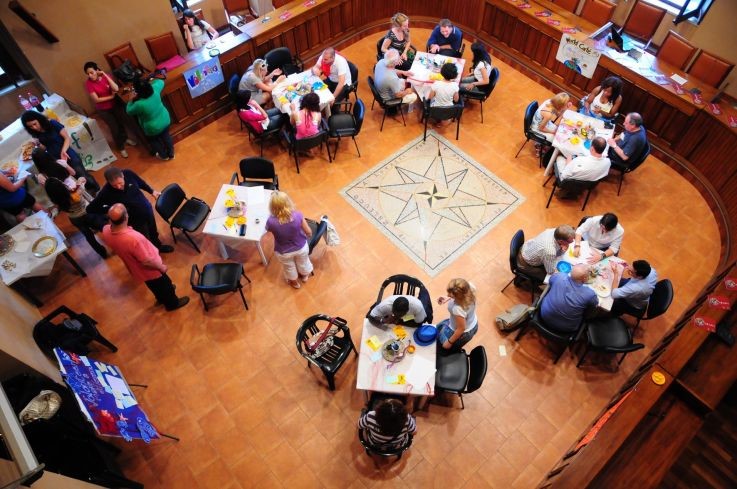World Café

Informal learning around the table
Overview
This activity is designed to spread ideas and expand insights through sharing experience. An open and creative dialogue is encouraged by replicating a café environment. Each round allows participants to rotate tables, creating a web of collective knowledge around the subject matter. The method assumes that people themselves are sources of wisdom, and that creating a constructive context around a table can draw valuable lessons to the surface.
How to use it
- Evoke collective knowledge within a group of at least 12 experienced participants.
- Engage in collaborative problem-solving that cuts across standard constraints.
- Discover more new insights than with traditional panel presentations, due to its participatory nature.
- Generate meaningful interaction by limiting hierarchical distinctions.
How to apply it
Start:
- Identify the purpose and establish the parameters before the session, to ensure that the World Café will foster creative discourse while remaining focused on the subject.
- Design questions that are thought-provoking. A good question may have many answers and will allow the participants to examine the complexity of the issue. See ‘How to adapt it’ below for ideas on dealing with them.
Setting:
- The ideal number of participants per table is 4 to 6. Any more will stifle the opportunities to contribute, and any less will reduce the amount of experience that is shared.
- Cover the tables with flip-charts or brown paper. Participants should be constantly encouraged to take notes, doodle or create diagrams directly on the table. The table host in particular should be instructed to keep track of key ideas.
Time/Steps:
- 15-30 minutes: Each round of conversationshould last about 15 to 30 minutes.
- Participants sit at a table and hold a conversation focused on key points that relate to the questions. They must contribute their own thoughts and ideas regularly. They should also listen actively for interesting connections, patterns or additional questions.
- Each table selects an ‘ambassador of meaning’, who stays at the same table for the next rounds, while other participants move to other tables.
- The ambassadors of meaning provide an overview for the next group and steer them towards complementary thought processes in order to avoid repetition.
- Debrief: After 2 or 3 rounds (depending on time allocated) close the session with a debriefing. It is not necessary for all people to spend time at each table.
- The ambassador of meaning from each table presents a synthesis and key reflection points to the entire group of participants, either from the table itself, or gathered in one location, depending on room set-up and size.
- Allow time for the other participants to add interesting points or further lessons learned after the debriefings.
- Provide key learning points in a supporting document or online for future reference by the participants.
How to adapt it
- How the questions are assigned to tables will depend on the objectives of the exercise. Telling each table to deal with different aspects of a problem, or providing diverse case studies to each, are just two approaches.
- The exercise can be re-named for different purposes. Appropriate formulation of table questions and learning objectives can create a knowledge café, strategy café, discovery café, or various other forums that connect participants.
- Divide the groups into homogenous tables if there is diversity in language, opinion, interest, geographic or demographic situation that may hinder the exchange process.
Case study
Title:
Inner workings of a world café
Activity:
Labour market inclusion of people with disabilities
Contact:
A.Molz@itcilo.org (Employment and Skills Development), M.Lisa@itcilo.org (DELTA)
Description:
A ‘Knowledge Café’ was designed in conjunction with a pre-course assignment to bring out subjective perspectives on the topic. Participants were told to answer three questions given as a written assignment in Phase 1. On the first day of the face-to-face program, one table was nominated to explore each of the questions. Participants were informed of the process and provided with a paper summary to avoid confusion. The groups of three rotated through each table, always leaving a ‘host’ behind to guide the newcomers. The reflections were recorded on flip-charts, rather than written directly on the table. Photographs were taken of the flip-charts and shared on the end-of-activity CD. The exercise was designed to foster awareness of diverse perceptions and establish relationships among peers. The learners themselves introduced key aspects of the learning program, and countless people asked permission to use the method when they went back their own institutions.
Tips
- Be sure to provide a minimum of 60 minutes and no more than 2 hours for the World Café, to ensure that the questions are thoroughly examined and to avoid boredom and repetition.
- Further questions that deepen the analysis of the subject can be posed to the tables during the last round of conversation. Be sure that the questions are complementary and relevant.
Resources
- More information about the design of a World Café: http://www.theworldcafe.com/
- Great book available from Learning Resources and Information: “The Change Handbook”, P. Holman, T. Devane and S. Cady, pp. 179-194.
- Video all about the World Café from the creators: https://www.youtube.com/watch?v=1cv82Yl0H7M




